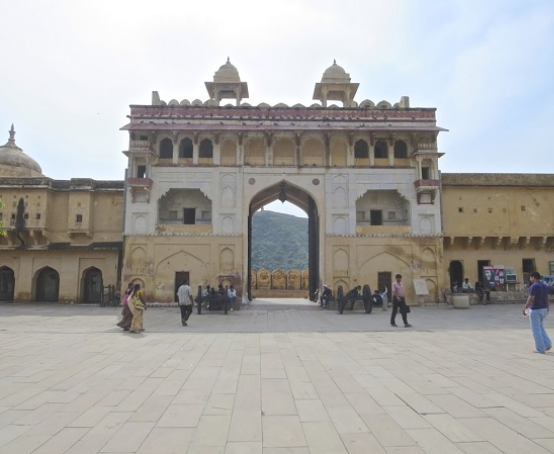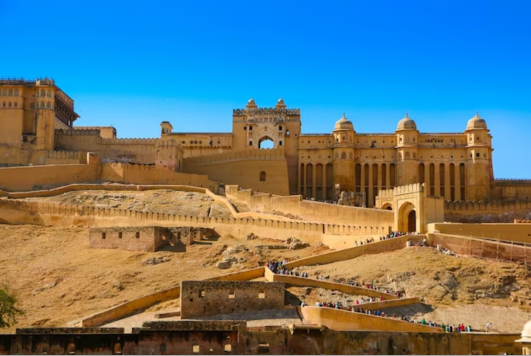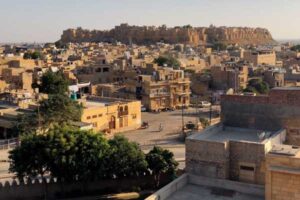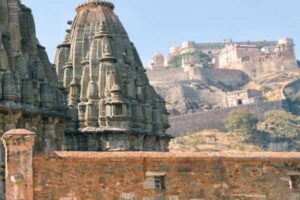Amer Fort Jaipur
Amer Fort jaipur
Many brave deeds and tales of Rajputana pride are set in Jaipur, the state capital of Rajasthan. There is a lot that Jaipur has to offer on a walk around the city if all you see are the newer homes and schools that make up the urban core of the city. As shown by the building of this amazing fort and the rest of the city, Jaipur’s history encompasses not just the valiant acts of its kings and soldiers but also their support of the arts and sciences. Amer Fort is the ideal illustration of this. The best proof that Jaipur’s history extends beyond the valiant actions of its rulers and soldiers is this fort.
The Rajputana kingdom chose Jaipur, sometimes referred to as the Pink City, as its capital due to its advantageous position and built-in defenses—hills encircle the city on three sides. The Kachhwaha dynasty controlled Jaipur throughout its time as a component of the Rajput empire. They formed an alliance with the Mughals in order to vanquish the Sisodia clan of Rajputs, who were their shared enemy.
Most people agree that the world’s first planned city was Jaipur, India. In the ancient Rajputana style, building construction was encouraged by Maharaja Sawai Jai Singh. Thanks to the efforts of Bengal’s chief architect, Vidyadhar Bhattacharya, the city’s design was constructed according to the principles of Shilpa Shastra. The building of Amer Fort also made use of these concepts. The most famous landmarks in the state were constructed using sandstone, which is widely available throughout the state.
COST EFFICIENT SERVICES
Provide highly efficient services at very competitive prices.
ATTRACTIVE PACKAGES
Exclusively customized packages for Rajasthan & India tours.
CAR RENTAL SERVICES
Hire a taxicab in Jaipur for local sightseeing and outstation needs.
100% SATISFACTION
Our company provides 100% customer satisfaction as it is our top priority.
24+ Year
Experience
20+ Tour
Destinations
15000 + Happy
Customers
Overview Of Amer Fort jaipur
You may get a taste of the Rajputana people’s regal grandeur as you stroll through the pink and yellow sandstone of the Amer fort’s magnificent complex. Jaipur, often known as the “Pink City,” is home to this royal grandeur, which can be seen atop the Cheel ka Teela (Hill of Eagles) in the heart of the city. The city of Jaipur wears the fort like a crown because it is so magnificent. More than five thousand sightseers take in the fort’s historic grandeur every day. The Amer fort, along with five others in Rajasthan, is a part of the UNESCO list of world historic sites. Rajasthan got this recognition.
The fort’s fame stems from the spectacular Hindu elements that is visible popping out of the architecture. Large parapets and ornately carved doorways give the palace a stately air from every angle. The building of the fort originally took place by Raja Man Singh, monarch of the Rajputs, in 1592.The fort is an iconic landmark, as well as a superb architectural representation of the Rajputana style. The elephant rides and the music and light show are the two main draws, drawing in thousands of visitors every day. Indeed, the fort is a fantastic example of the creativity and ability of the Rajput architects and craftsmen who built it. The Amer Fort is one of the oldest structures in Rajasthan and a great resource for learning about the state’s illustrious past.
History of Amer Fort
Under the leadership of Raja Bharmal and Raja Man Singh I, construction of the Amer fort got underway in 1558. Three different rulers collaborated to build the fort over the course of two centuries. In 1727, Raja Sawai Jai Singh II finished it. The royal family relocated to Amer Fort, a more modern fortress in the city, from Jaigarh Fort, an older structure.
Although the Amer and Jaigarh forts are considered to be independent structures, people sometimes see them as a single structure because of their shared corridor. In the event of danger, the royal family and their attendants would take refuge in the Jaigarh fort. The Jaigarh fort is referred to as the “old palace” and the Kadimi Mahal.
The Meena clan’s capital was Amber, or Dhundar as it was once called. In the 1600s, the Amer fort was being built by the Kachhwaha rulers, who had earlier taken the area from the Meenas. The etymology of the term “Amber” has been traced back via many sources.According to some tales, its name comes from Ambikeshwar, another name for Lord Shiva. It is said that the symbol of Lord Shiva’s linga was dropped into a lake in the middle of Amber. Jain inscriptions from the 16th and 17th centuries address the name’s purported deity-derived origin. According to a different story, the name Amba means “universal mother.”

It is said that the Meena family was slaughtered during the Diwali celebration by Dhola Rae, the adopted nephew of Raja Alan Singh, the reigning ruler of Amber at the time. Although there is no written record of a battle between the Kachwaha and the Meena, it is often assumed that the Kachwaha had previously taken control of the settlement. This urban tale blames Dhola Rae for carrying it out.
The second son of Lord Ram, Kush, is often cited by the Kachhwaha people as their ancestor. Tragically, Raja Sora Singh, the son of Raja Nal, one of his ancestors, perished in combat. When a Brahmin’s wife and baby were out picking wild berries, he sensed right away that they were going to be very successful. Following that, she travelled to Khogong, which was then ruled by Raja Alan Singh and known as Amber, in search of safety.
He made her and Dhola Rae his brothers and sisters when he adopted them. When Dhola Rae was fourteen years old, he was sent to Delhi to start his political education. Upon his return, he led an army of Kachhwahas to Amber in an attempt to take over the kingdom. The Meenas were required to set down their weapons according to a custom known as Pitra Tarpan. When the Kachhwaha spotted their opportunity, they attacked, which finally resulted in the Meenas’ loss and Amber’s arrest.
What to See
Amer Fort Light and Sound Show

The glorious history of the Rajput kings who ordered this building of the fortress is in mention throughout the play. A spectacular light show illuminates the whole fort at night. In the start of the presentation, the origins and development of the programming are also subject to discussion here. After then, it describes the royal rulers’ daily life in the fort and how they utilized it to manage their kingdom.The book is replete with fascinating stories that shed light on the perseverance and magnificence of the Rajput kings and queens. Amitabh Bachhan’s unusual voice narrating the film further adds to its already legendary stature. Only Gulzar could have written such a beautifully crafted tale.
This event is made even more remarkable by the superb high-definition surround sound that you will not soon forget. You may fall into a trance while lounging on the open terrace. The song was written by renowned singers Sultan Khan and Shubha Mangal.
The show runs for about an hour and ends with a rundown of when it gets open to the general audience. The story is available online in either English or Hindi. If you do visit the Amer Fort, you won’t want to miss the performance, which will be a crown gem among the many other impressions you’ll take away from your trip. A ticket to the show is 100 rupees and may be purchased at the box office.
Elephant Ride

Riding elephants through the royal grounds to the innermost courtyard seems like an incredible adventure. Your mood will be subject to change by the roller coaster of emotions you experience while riding on the elephant’s back. Tourists at Amer fort are urged to take part in this event. Therefore, the great demand for elephant rides means that the booking of almost all of them becomes full each day in advance. As you climb the hill, you’ll be treated to breathtaking panoramas.
Museum and Garden Visit

You may find out more about the palace’s and the Rajputs’ history by visiting the museum housed inside it. Located amid the fort’s Turban museum, the beautiful Char garden is yet another must-see site. This garden, perched atop the fort, looks out over the city below in all its splendor.
Dance Programs

Sukh Mahal hosts exciting and interesting dance acts nightly. You may purchase tickets to see authentic Rajasthani dance performances at the box office.
Dining Experience

The Fort also has a restaurant that serves delicious food from a range of cuisines. The menu at Surabhi may be subject to customization to suit the tastes of diners from any country. Restaurants provide both international food and regional delicacies from Rajasthan, such as daal bati and Gatte ki sabzi.
Puppet Shows

Funny puppet shows and dances are presented for diners to liven up the meal. All visitors may expect a dynamic and engaging environment thanks to their efforts. The little, traditionally clothed puppets that put on intriguing performances are a big hit with the tourists from abroad.
Architecture of Amer Fort
Raja Man Singh I of the Meena dynasty started building the fort in 967 A.D. Before the 16th century saw the beginning of work on the current fort, the old Meenas structures were mostly destroyed. The fort’s construction, which combined Hindu and Mughal architectural traditions, is shown by the use of both white marble and red sandstone.
These additional influences are combined with Mughal floral designs seen in the wall sculptures that portray episodes from the Ramayana and the life of Lord Krishna. These engravings show both of the narratives. Every one of the four storeys of the fort has its own personal courtyard. The fort’s interior is arranged approximately as follows:
First Courtyard

The Sun Gate, also known as Suraj Pol, received its name because of its closeness to the sun. Every day, you may see the sun rising through the door, which faces east. The Suraj Pol is the entrance into the city, and you will arrive at Jaleb Chowk. This area was used as the victor’s and their troops’ parade route after the battle.
Here, the troops under the command of the army’s commander, Fauj Baksh, would gather to celebrate their successes. The women would look out the windows, called jharokhas, to see the festivities below.
The shrine of Sila Devi is located to the right of Jaleb Chowk. The beautiful marble sculptures and two silver-plated doors make up the temple’s doorway. The deity that now resides within the temple was given to Raja Man Singh by the ruler of Jessore, Bengal, in 1604, after his army’s victory in a major battle.
On the eighth day of Navratri, animal sacrifices were traditionally offered in front of temples; however, this practise was outlawed rather recently. Except for the royal ladies, nobody was allowed inside the Suhag Mandir, which was located slightly above the main entrance.
Second Courtyard

Reached from the first courtyard by a staircase, the second courtyard housed the House of the Commons (Diwan-e-Am) and the House of the Officials (Diwan-e-Khas). An elephant-shaped ornament was perched atop each of the 27 columns that were equally positioned around the elevated platform.
But the Diwan-e-Khas was reserved for official state policy matters, such as taxes, revenue collection, and security, and was inaccessible to anybody who was not a minister of the appropriate subject. The nobility could hear the worries of the common people and attempt to find remedies at the Diwan-e-Am. The only people present at the Diwan-e-Khas were ministers of the pertinent topics. The Jai Mandir, which was adorned with flowery glass tiles to represent the Mughal influence, was situated atop the Diwan-e-Khas.
Third Courtyard

The palace crew welcomes guests as they enter the royal family’s official house via the Ganesh Pol. The walls are covered with mosaics and etched sculptures. The well-known Sheesh Mahal, constructed in 1727 by Raja Man Singh II, is located within this courtyard. Several festivals and triumph celebrations took place here.
The concave mirror-covered walls of Sheesh Mahal allowed enough light to fill the whole palace with a few candles. This made the palace’s interior seem more private. The door of the Sukh Mahal, which faced the Sheesh Mahal, was made of sandalwood. The addition of channels along the walls contributed significantly to the building’s capacity for cooling.
There was always fresh water available for these pipelines from the Maotha Lake. The Magic Flower is etched on the top side of the gate. But before it could be seen, the panel had to be partly hidden.
The oldest building in the complex, Raja Man Singh I’s palace, is located in the third courtyard. It’s an old building from the 1600s. Though it took about 25 years to finish, it was eventually finished in 1599. The closest town to the palace, Amer, was visible from the palace’s exit.
Fourth Courtyard

The Zanana Dyodhi is visible to everyone who enters the fort from the Tripolia gate on the western side. This part of the fort is intentionally divided from the rest by a wall. The queens, their mothers, and their attendants all called Zanana Dyodhi home. There is no mistaking how this edifice was built.
The king could not have been seen by anybody, and the other queens would not have known if he had remained there with one of his queens. This may have been done well because of the framework. Smaller corridors separated the queens’ private chambers in Zanana Dyodhi from the main hallway.
The fort’s unusual shape came from a unique blend of Mughal influence and the ancient Hindu architectural treatise Shilpa Shastra. In the Sheesh Mahal, mirror-inlaid jharokhas and jalis were reinterpreted; in the Man Singh palace, the garden bore a resemblance to the Chahar Bagh; in the Ganesh Pol, intricate paintings adorned the walls; and so forth. These were often used as coalition emblems in politics as well.
The Current Position

Kachhwaha rulers finally gave up on Amber when Raja Sawai Jai Singh II suggested shifting the capital from Amber to Jaipur in 1727. Jaipur would become the new capital. The strategic superiority of Jaipur over its prior location led to its selection as the new capital. As a result, it was less likely that the king and his advisors would be ambushed easily and simpler for them to monitor the kingdom’s borders.
But Amber wasn’t written off entirely. Amer Fort’s survival was probably aided by the trade route that connected Gujarat to the city, even if many other abandoned forts ultimately collapsed due to weather.
How to reach
A bus from the airport to Amer Fort is an option; the trip takes around 1.5 hours. The airport shuttle is the cheapest way to go to Amer Fort. One other option is to take a cab straight from the terminal. The trip to the Amer fort in a taxi shouldn’t take more than twenty minutes.
Best Time To Visit
It’s possible that Jaipur’s summers and winters are quite harsh. Visit the Amer Fort between September and March for the greatest weather. All during these months, the temperature stays comfortably pleasant. The fort looks the best in the evening, namely between 7 and 9 p.m., when a sound and light show takes place and a five-star supper may be had at the onsite restaurant







